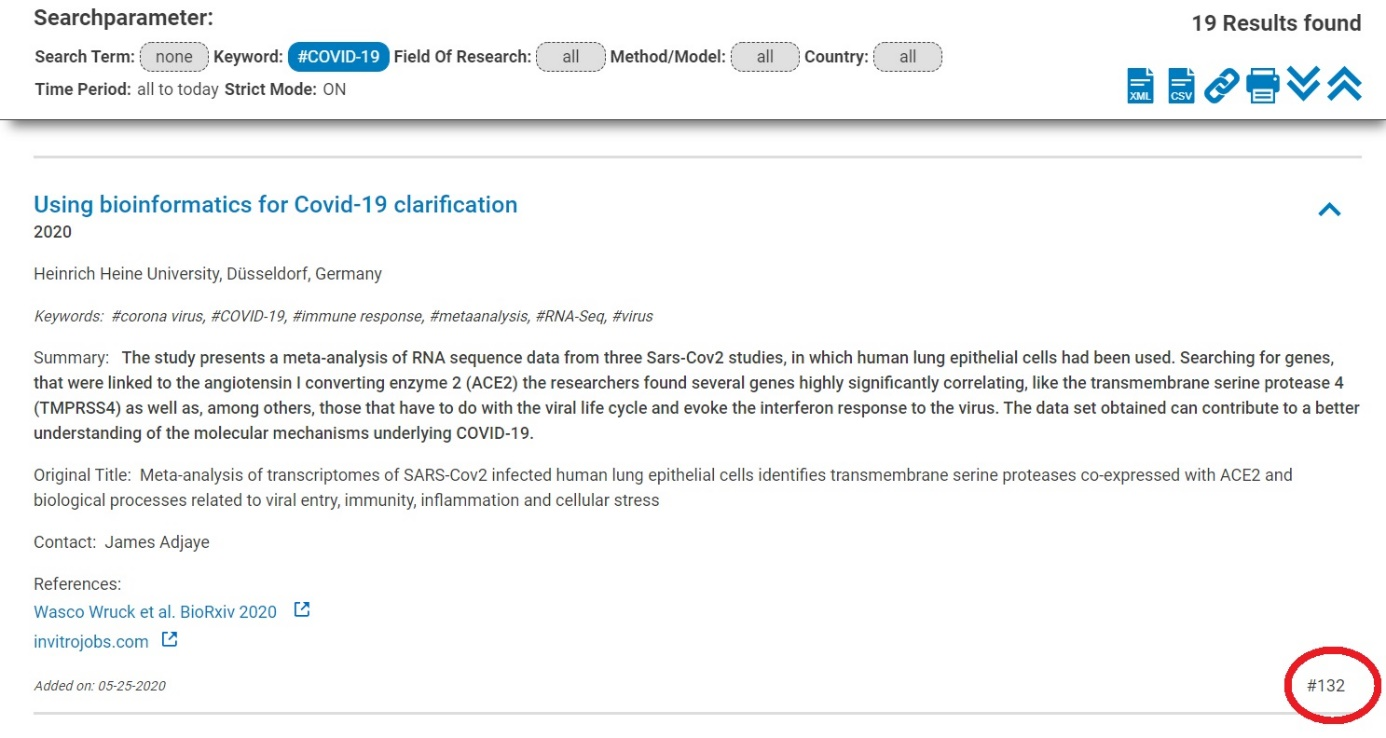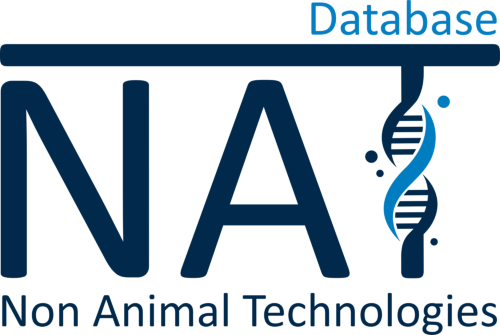Frequently Asked Questions
The NAT Database (Non Animal Technologies) is a free, publicly available database containing various non-animal research methods that are developed worldwide. These include, for example, modern in vitro methods based on human cells or in silico approaches utilizing computer models.
Diverse research areas are listed, encompassing methods developed by universities and research institutes as well as commercially available or regulatory accepted techniques.
Each database entry contains a summary of the research method, information about where it was/is developed and the respective contact details. The sources on which the entry is based as well as the publication date and suitable keywords are provided.
The database is online since 29 July 2020 and is constantly being updated and expanded with new methods. If you find no results for certain subject areas, this does not mean that no suitable non-animal technologies exist, but rather that up until now no methods have been added to the database for these areas.
Each database entry contains information on the corresponding sources. These are mostly scientific publications, but also press releases from universities or research institutions, products or services from companies in the life science industry and contributions from specialized portals.
The database is intended for scientists and physicians from all disciplines as well as for authorities, politicians and the general public. The NAT Database highlights human-based research methods and provides the possibility of networking and establishing contacts with researchers, companies and agencies in this field.
Scientists, physicians and students interested in human-based research can explore available NATs and can contact researchers who already work with these methods.
Regulatory authorities can get informed about human-based alternative methods for achieving particular research goals before approving animal testing applications.
Politicians can get an overview of how advantageous and reliable non-animal methods are for predicting the safety and efficacy of chemicals, active ingredients and medicines.
Funding agencies and foundations can see for themselves how efficient these methods are despite currently low funding and shift the (public) funding focus towards these innovative methods.
The general public can get an impression of the variety of human-based, non-animal methods.
The database offers a full text search. You can enter multiple words separated by commas. In this case, all results containing one or more of the words are shown. Thus, you get more results instead of fewer if you enter two words instead of one, for example.
Example: A search for "toxins" returns 3 results and a search for "dementia" - 5 results. A combined search for “toxins, dementia” returns 8 results.
As you type, search suggestions preceded by a # appear automatically, these are keywords.
Example: A search for "RNA" finds 66 entries containing the word RNA. A search for "#RNA" only finds one entry that is marked with the keyword "#RNA".
The strict mode, which can be switched on and off, limits the search results to entries containing the search terms as separate words and excludes entries where the search terms are found as parts of a word.
Example: If you search for "RNA" with the strict OFF mode, you will find entries in which the word "RNA" is used as a separate word or as a component of specific (e.g. "RNAseq") and non-specific (e.g. "Journal") terms occurs. If the strict mode is ON, you will only find entries in which "RNA" appears alone or as a combination of words (e.g. "RNA-based").
All #keywords shown in the results are links itself. By clicking on one of them, you can start a new search.

The NAT Database is bilingual. You can always switch easily between the languages German and Englisch. Already set filter options and results remain intact.
You can restrict your search by setting specific search parameters like fields of research and models, and you can also filter the results according to the year of publication and the country in which the method is used or described/developed.
To narrow down or specify your search results, it may be sensible to activate the strict mode. In strict mode ON, you search for terms as separate words and not as parts of a word.
Search results are sorted by their date of publication with most recent technologies found at the top. Entries without a publication date such as webpages of companies are found at the bottom of the list.
Search results can be sorted by other parameters after export as CSV or XML file.
There are several ways to copy or export search results. These are shown as blue symbols in the top right corner of the search results list.

The double arrows allow you to switch between a short and a detailed display version of the search results.
You can save and export the search results as an Excel table (XML or CSV format). Alternatively, you can print out the list or save it as a PDF using the printer button.
The chain-link button copies the link to your search results to the clipboard so you can share your results with others.
Via the ID, found at the bottom right corner of each entry (e.g. #132), the method can be displayed in single view mode and thus also saved/sent/printed. A search for one or more IDs is also possible using the "#ID" format. For example, the search for "#139, #45" finds the entries with the IDs 139 and 45.

You can also display a single entry by using the URL "nat-database.org" in your Browser and adding the desired "/ID" behind.
Example: nat-database.org/139
The NAT Database is online since 29 July 2020 and is continuously being manually updated and expanded. Each database entry is individually analysed, summarised and uploaded by our scientific team. If you find no results for certain subject areas, this does not mean that no suitable non-animal technologies exist, but rather that up until now such methods have not been added to the database due to organizational and/or time limitations.
If you would like to have a method added to the database, please contact us: info@nat-database.org!
There are interesting and promising developments for which no scientific paper have yet been published or the methodology is not described in detail. Since these methods should not be excluded, other technical sources are also taken into account, e.g. products and services offered by companies or university press releases about new research projects.
The methods that have been officially validated by ECVAM (European Center for the Validation of Alternative Methods, EU), ICCVAM (Interagency Coordinating Committee on the Validation of Alternative Methods, USA) or a comparable institution are listed in this database as “validated methods” and can be selected under “Method/Model ”. If the procedure is also accepted for regulatory purposes, this will be mentioned in the summary and the entry will contain the keyword "#regulatory acceptance".
Due to lengthy, complex and costly validation procedures, many promising methods are not submitted for validation or the validation - after the development of a non-animal method - is not pursued further. A supposedly small number of validated methods, therefore, should not affect your assessment of the quality of other NATs that are not (yet) validated.
We look forward to citations of the NAT Database in publications, lectures and other materials. If you want to quote the NAT Database for your work, please refer to "NAT Database, www.nat-database.org".
If you would like to have a non-animal method included in the database, please contact info@nat-database.org!
The database is continuously being updated and every new entry is thoroughly checked, including the functionality of the links. Of course, links may no longer be available after some time.
If you find a non-functioning link, please give us short feedback at info@nat-database.org, specifying the ID of the entry. Thank you!
Nowadays almost all web pages contain JavaScript, a scripting programming language that runs on visitor's web browser. It makes web pages functional for specific purposes and if disabled for some reason, the content or the functionality of the web page can be limited or unavailable.
Internet Explorer: The IE from MS no longer understands current scripting languages, the latest main version (version 11) is from 2013 and has not been further developed since 2015. Our recommendation: Use only the latest versions of modern browsers, for example Google Chrome, Mozilla Firefox or Microsofrt Edge, because only this guarantees you sufficient protection against infections and the correct display of websites!
If you have any questions, suggestions or problems, or if you would like to have a method included in the database, please feel free to contact info@nat-database.org !




